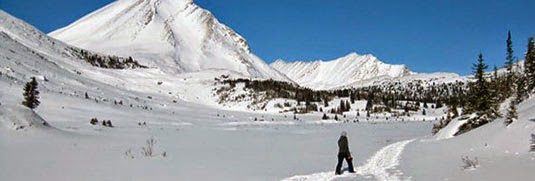Algorithms in the Wild
 [Image: Jasper National Park, courtesy of Parks Canada].
[Image: Jasper National Park, courtesy of Parks Canada].There's an interesting article over at Highline Magazine about a lost hiker named George Joachim whose subsequent behavior in the landscape was so spatially unexpected that he eluded discovery for ten days.
He was a "behavioral outlier," we read, and his mathematically unpredictable actions forced a revision of what is, in effect, the search algorithm used by Parks Canada for tracking human beings in the wild.
 [Image: Jasper National Park, courtesy of Parks Canada].
[Image: Jasper National Park, courtesy of Parks Canada].From the story:
Parks Canada uses a statistical model to help predict where the lost person might be. The model uses data collected from similar lost person cases to learn the size and location of the search area. Combining the experience of the searchers and research on the lost person, the model then suggests the likelihood the person will be in various locations based on how previous people in their situation have behaved.Put another way, this hiker exceeded the agent-based mathematical model used to track him. As a result, his searchers were forced to develop what the author calls the "Joachim profile," a kind of makeshift simulation that, in theory, should have been able to predict where he'd pop up next.
Joachim unintentionally misled searchers by listing his destination incorrectly in the climber’s registry, and then behaved so unlike other people previously have in his circumstance that he was repeatedly missed in the search. Parks Canada’s search and rescue community considers his case a valuable learning experience and have since tweaked search protocols to account for other behavioral outliers.
The idea that human movement through the wilderness corresponds—or not, as the case may be—to a mathematical sorting algorithm is fascinating, especially when that model diverges so drastically from what a person really does out there.
In fact, it's worth speculating that it is precisely in this divergence from accepted mathematical models of landscape use where we can find a truer or more "wild" experience of the terrain—as if certain activities can be so truly "wild" that no known algorithm is capable of describing them.
 [Image: Jasper National Park, courtesy of Parks Canada].
[Image: Jasper National Park, courtesy of Parks Canada].In any case, it's by no means the world's most gripping story of human survival, but it's a great example of human landscape expectations and the limits of abstract modeling. Click over to Highline to read the whole thing.





Comments are moderated.
If it's not spam, it will appear here shortly!
It's interesting to think that acting 'wild' in the wilderness, that is: acting in a truly random way, is something almost impossible for someone who lives or works there.
People who live in and use the wilderness are more likely to have a very careful rationale for everything they do, every movement and expenditure of energy would be carefully assessed, and therefore rational.
Whereas someone who is a product of civilization and therefore simply doesn't know what the fuck they are doing may therefore be the only reliable source of 'wild' movement.
Abstract modeling fails in this area because:
"A good predictive model requires a stable set of inputs with a predictable range of values that won't drift away from the training set."
http://www.john-foreman.com/blog/surviving-data-science-at-the-speed-of-hype
Modeling human behavior is difficult, because humans do not have a "predictable range" of behavior.
Post a Comment